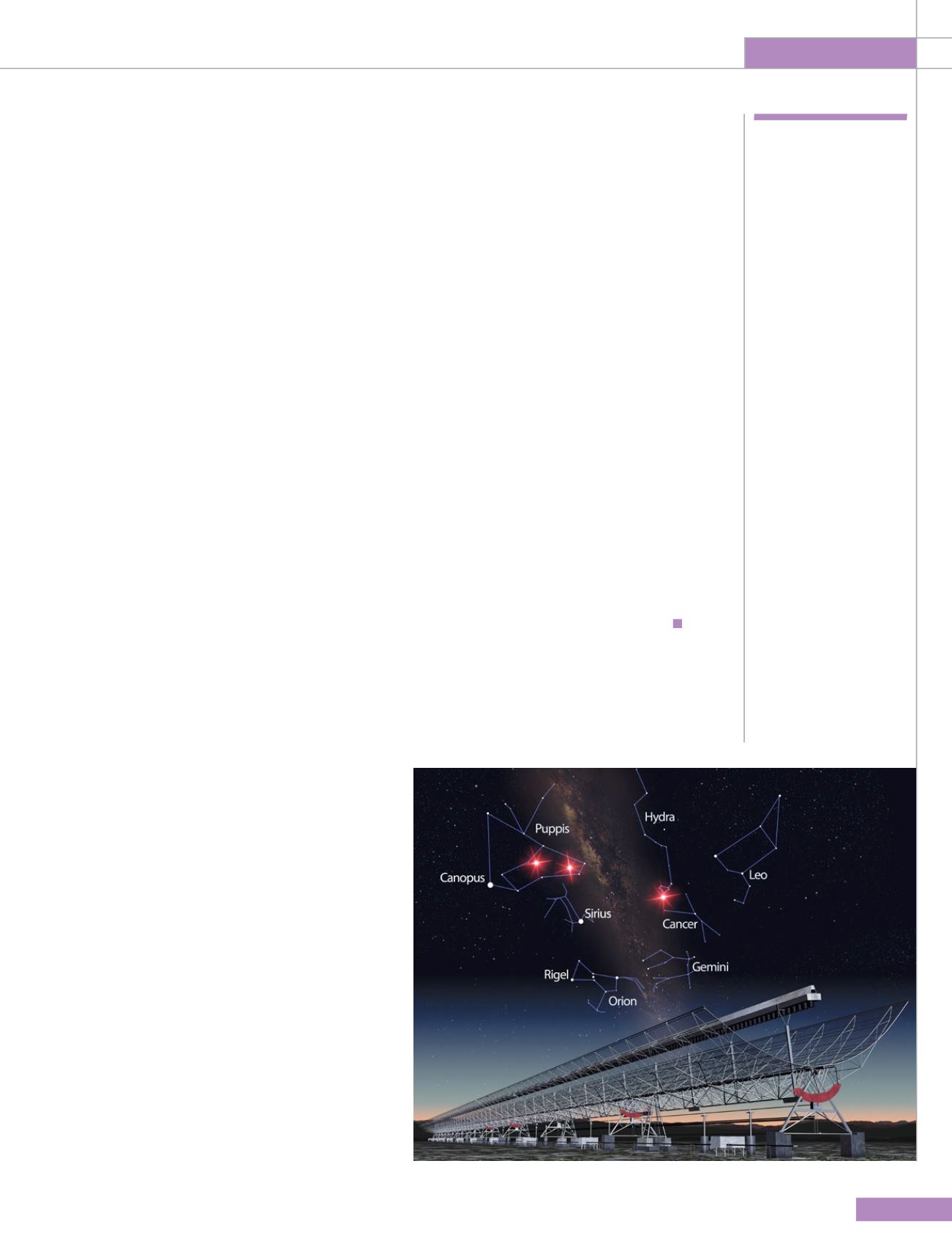
ROOM
83
Space Science
in excess of the Milky Way’s contribution. The key
to progressing in the field of FRBs lies in localising
them the instant they happen which in turn
requires an ‘interferometric detection’ in the radio.
First interferometric detections
Until 2016, each one-off FRB event was discovered
using a single dish telescope, such as the Parkes
radio telescope in Australia. This generally results in
a detection with relatively poor angular resolution,
meaning researchers are unable to indisputably
rule out a near-field or atmospheric origin. In
astronomy, the larger the telescope the more signal
it can collect. Consequently, this means that it has
a small field-of-view, while the inverse is true for a
smaller dish - it collects a weaker signal but has a
larger field-of-view. An interferometer is a special
type of radio telescope formed by linking many small
telescopes together electronically to form one large
telescope. This way, it retains a large collecting area,
as well as a large field-of-view, which is excellent for
blind searches as in the case of FRB searches.
The Molonglo radio telescope near
Canberra in Australia is a Mills cross-design
interferometer and a potential gold mine for FRB
discoveries. This 50-year-old telescope has been
refitted and refurbished with a new digital back
end system to be transformed and reborn into
an FRB hunting machine.
The telescope’s unique architecture can place
a minimum distance to the FRB bursts due to its
large focal length unlike single dish telescopes.
Molonglo made the first interferometric
detections of FRBs in 2016, ruling out local sources
of interference as a possible origin and confirming
their extragalactic nature.
Molonglo consists of two arms, each 1.6 km long
and intersecting one another in the form of a cross.
Presently only the East-West arm of the telescope
is fully functional, which can be thought of as 352
little telescopes all looking at the same patch of
sky. Each of these 352 telescopes produces signals,
which are digitised and combined to create a more
sensitive and cleaner signal.
Like most astronomical observations, FRB
detections require high frequency and time
resolution, and a supercomputer to process the
resulting data. With the aid of graphic processing
units (GPUs) - 54 to be exact - originally designed
for the video games industry, the Molongo
inteferometer receives one petabyte (PB) of data a
day (the equivalent of 200,000 DVDs a day where
each DVD is 5 GB), that is processed on its mini-
supercomputer, helping to munch through the
data faster than real time.
Early rate
estimates
suggested that
there could
be as many as
seven FRBs
per minute
Future of FRB research
The success of the Molonglo radio telescope
observations has helped confirm the extragalactic
nature of one-off FRB events, though the exact
localisation of the FRB position on the sky, still
remains ambiguous. The signal can be limited to
within a long line on the sky but to truly pinpoint
the FRB event, further resolving power is required.
Luckily then, in the next couple of years the
North-South arm of the Molongo inteferometer will
come online as part of the UTMOST-2D project.
Once operational with both arms up and running,
UTMOST will be able to localise an FRB burst within
a few arcsecond radius (an arcsecond is about the
width of a human hair seen ten metres away). X it
would seem, will figuratively mark the spot. Once
the burst location is determined scientists will
have all the information needed to identify its host
without having to look for repeat pulses.
Without a doubt, the key to understanding
these enigmatic bursts lies in localisation, and
observations at additional wavelengths would
not go amiss either. Once we understand the
FRB population, given the large discovery rates
expected from future and present telescopes, we
can expect the next decade to answer some if not
all the open questions in FRB astronomy.
About the author
Manisha Caleb
is a postdoctoral researcher at the University of
Manchester, UK, in the area of radio and multi-wavelength astronomy.
Her research is related to the attempts to search the radio sky for
pulsars and fast transients and to rapidly and accurately locate them
and understand their origin and characteristics.
ESA
James Josephides/Mike Dalley


